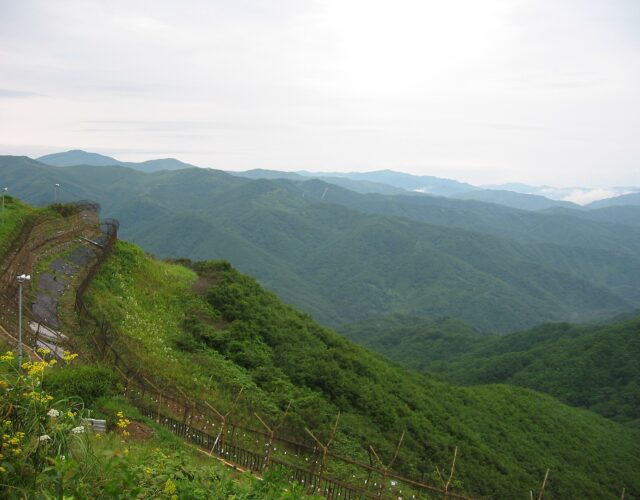When we think about Korea’s demilitarized zone, we may not immediately think about the pristine rivers and forests that have been able to flourish since the war. Sam Kean explores this contradiction, and the hope that this beautiful sliver of land may be a small bit of common ground for the two Koreas to stand on.
About The Disappearing Spoon
The Science History Institute has teamed up with New York Times best-selling author Sam Kean to bring a second history of science podcast to our listeners. The Disappearing Spoon tells little-known stories from our scientific past—from the shocking way the smallpox vaccine was transported around the world to why we don’t have a birth control pill for men. These topsy-turvy science tales, some of which have never made it into history books, are surprisingly powerful and insightful.
Credits
Host: Sam Kean
Senior Producer: Mariel Carr
Producer: Rigoberto Hernandez
Associate Producer: Padmini Raghunath
Audio Engineer: Jonathan Pfeffer
Transcript
New Year’s Day is the biggest holiday of the year in Korea. It takes place in January or February, on the second new moon after the winter solstice. Traditionally, boys fly kites emblazoned with wishes for the new year, then let the kites do battle in the sky. Girls play games where they jump on seesaws, and send each other flying acrobatically into the air.
There’s also family time. Everyone gathers at a relative’s house, and dresses in brightly colorful outfits called hanbok. Children get gifts of crisp paper money inside silk purses. Adults exchange small gifts as well—cooking oil, fancy nuts, even Spam nowadays. Then there’s a huge feast with fruit, desserts, and savory dishes.
Most importantly, people eat rice-cake soup. It consists of coin-shaped rice-cakes bobbing in beef broth. It might have eggs and scallions and other vegetables. According to tradition, when you finish your bowl, you’re officially one year older.
Like all ancient holidays, there are little superstitions surrounding Korean New Year Day. If you hear the chattering of a magpie <MAGPIE> that’s good luck. If you hear the caws of a crow <CROW>, watch out. You’re in for trouble.
The most lucky bird to see is the crane. <FLAPPING, CRANE CALLS> If you spy a crane soaring above you that day, graceful and majestic, that’s considered a blessing for the whole year. Korean New Year decorations often feature cranes for this reason.
Sadly, though, it’s getting harder and harder to see cranes in Korea. Explosive development in South Korea, as well as deforestation in North Korea, have all but destroyed their habitats. The most gorgeous crane of all, the red-crowned crane, has been reduced to just a few thousand individuals and is considered endangered. Biologists lament that the crane could disappear for good, relegated to the realm of art and misty memories. <FADING FLAPPING>
Still, there is one place where the cranes flourish today—just not a place you’d expect. In fact, to visit there, you’d have to be almost suicidally brave. There are landmines to navigate, barbed-wire fences to climb, <GUNS> machine guns to dodge. So what is this place? It’s Korea’s biggest natural wildlife refuge. But it’s more commonly known by another name. It’s the war-ravaged border between North and South Korea—the infamous DMZ.
<INTRO>
The Korean peninsula is the Poland of Asia, a land that’s been overrun time and time again. By the Chinese, the Mongols, the Russians. Before World War II, Japan colonized Korea, and after Japan’s defeat in 1945, there was a vacuum of power there.
Into that vacuum rushed combatants on both sides of the Cold War. U.S.-led forces backed a democratic government in the south. Soviet- and Chinese-led forces backed a communist army in the north. The Korean War was the result.
The Korean War is often called the “forgotten war,” but not for the people there. It was utterly devastating. The opposing armies deployed more napalm there than got used in all of the Vietnam War, and they deployed it in far more concentrated areas. This ravaged the landscape, burning up huge swaths of land. These tactics, along with intense aerial bombing, left five million people dead or wounded and made refugees of another five million.
The war ended in a shaky stalemate in July 1953, with Korea divided into north and south. To separate the countries, leaders set up a demilitarized zone, or DMZ. It was a thin twisted ribbon of land running mostly east and west—155 miles long and 2.5 miles wide. Before the war this land was mostly sleepy farmland, reclaimed from drained marshes and clear-cut forests. It was supposed to be a temporary boundary until Korea united again. But you know what they say: there’s nothing so permanent as a temporary arrangement.
There used to be a dozen roads and four railroads running north and south through the DMZ, but all of them were cut off. And to make sure no one could get through on foot, both sides threw up huge barricades and electrified fences with concertina wire. Soldiers with guns also patrolled the perimeter. It was two hated adversaries, glaring at each other across a thin strip of land.
Unluckily, a few villages were caught within that strip of land. On the South Korean side at least, they’re most farmers. They sell bags of rice stamped “DMZ” as ghoulish souvenirs.
The main South Korean village, Tae Sung Dong, has about 200 people. It also has one of the world’s largest flagpoles, a tower 320 feet tall. The flag alone on top weighs an incredible 287 pounds. The South Korean government erected it in the 1980s, essentially as a big middle finger to the North Koreans who could see it.
Not to be outdone, the North Korean government built an even larger flagpole in a village on the other side, with a 535-foot tower and a 600-pound flag. It would take gale-force winds to even coax a ripple from a flag that big. Charmingly, the North Korean village also has gigantic speakers that blare anti-democracy screeds day and night, along with some marching music to change things up now and then.
However amusing this posturing is, the DMZ remains a painful symbol of division in Korea—not to mention a source of constant fear. Bill Clinton once called it “the scariest place on Earth.” And given how high tension run there—especially after North Korea acquired atomic missiles—and you can see what he meant. It’s a terrifying place.
But that only makes the ecology of the DMZ all the more amazing. As early as the 1960s, biologists in Korea realized that something unusual was happening there. Beyond a few villagers, no humans were allowed to enter the DMZ. Roads and bridges fell into disrepair, and no one was clearing land for golf courses or malls. For the first time in tens of thousands of years, then, plants and animals and rivers could just … exist. They no longer had to compete with and fend off the pressures of human beings.
Luckily, the DMZ happens to cut through a cross-section of nearly every type of ecosystem in Korea—mountains, marshes, caves, oak and pine forests. So there were refuges for nearly every type of native creature. Abandoned farms also reverted to woodlanda, providing even more space.
As a result, wildlife in the DMZ is flourishing.
Among big mammals, the DMZ now boasts of leopards and lynxes and seals. There’s even a type of deer with fangs—actual fangs—fangs that would make a saber-tooth tiger jealous. Excitingly, people have also spotted rare creatures there, like the Asiatic black bear. There are also signs of the regal Siberian tiger, which was long thought extinct on the Korean peninsula.
Beyond mammals, the DMZ is even more important for birds—vultures, eagles, swans, ducks, woodpeckers. Many of these birds are migratory, and they stop in Korea on their way to Mongolia or China or Russia, or even lands as distant as the Philippines or Australia.
One thing migratory birds need is a safe place to rest on their journey, and the DMZ offers plenty of clean rivers and unmolested forests. For species like the red-crowned crane of Korean New Year fame, the DMZ has been THE difference between existence and extinction.
There’s a few interrelated reasons why Korea has so little untouched nature left. One is population density. Geographically, North Korea is the size of Mississippi—but with the rough population of Texas—26 million people in a state six times smaller.
South Korea is even more crowded. It’s roughly the size of Kentucky, but with 52 million people. Imagine squeezing the entire population of California into one-fourth the area … and then adding a-whole-nother Los Angeles in there. That’s South Korea. And because all those people need a place to live, nature gets squeezed out.
The other reason the environment has suffered in Korea is north-south competition. Both sides want to prove that their economic and political systems are superior. So, they undertake massive projects to boast and brag.
In the South that’s led to sprawling developments, industrial farms, and manufacturing plants—plus, all the pollution that accompanies such projects. In the North, that’s led to massive deforestation—plus, all the problems that deforestation entails, like erosion and pollution runoff into waterways.
Overall, Korea has denuded itself of much of its natural beauty. The DMZ is the one place were untouched landscapes and animals still thrive. Overall an estimated 5,000 species now live inside the DMZ, including 106 endangered ones.
But wait a second here. You might be wondering something. The DMZ is barricaded and heavily patrolled, all but cut off from the rest of Korea. So how do scientists know that nature is thriving there? After all, you can’t exactly waltz into the DMZ with a clipboard and start doing fieldwork. How do scientists study the place?
<AD BREAK>
They study it in a few different ways. They can use telephoto lenses and remote video cameras to spy on critters. For migratory birds, they can count the number of them flying in and out from other areas. Satellite footage has been quite helpful as well, especially in studying plants and the recovery of ecosystems.
Plus, there are soldiers mucking about all over. Now, I would urge caution here with accepting these soldiers’ stories at face value. After all, they’re young and scared and often sleep-deprived, and the power of suggestion is real. There’s a reason why the sailors of yore used to see bogus things like mermaids and kraken all over. But for what it’s worth, soldiers have claimed sightings of tigers and other big beasts, and these stories can supplement other data like paw prints or remotely captured videos.
The overall lesson is that, if given a real chance, nature can heal itself. In fact, the DMZ is not the only accidental nature preserve in the world. Take the Berlin Wall. For decades, there was a population of wild rabbits who thrived in the no man’s land between the two sides of the wall. There’s also the deer- and buffalo-filled Rocky Mountain Arsenal in Denver. It’s a formerly polluted ground where the military produced chemical weapons during the Cold War. Heck, even Chernobyl—the nuclear-meltdown site in the former Soviet Union—is now more or less a nature park, with boars, wolves, bears, and wild horses running around.
But among all these involuntary parks, the DMZ stands out, both for the amazing animals there, and for just how pristine it is—a scar of war that, once healed, became more beautiful than everything around it. In olden times, people sometimes called Korea “Keum-Su-Kang-San”, or “the land of embroidered rivers and mountains.” And the DMZ is a rare place where that nickname still holds true.
So what does the future hold for the DMZ? Both North Korea and South Korea say they want a united peninsula—albeit only on their own terms. But just like with the once-bitterly-divided East and West Germany, you have to think unification will happen someday. And then what?
Unlike when the Berlin Wall fell, you won’t have people rushing across the DMZ pell-mell after reunification. Roads and rail-lines need to be rebuilt; and more importantly, there’s an estimated one million landmines in the DMZ, which would cost an estimated billion dollars to remove. Birds and most other critters don’t set the mines off, because they weigh too little, but people would.
Still, with enough effort you can remove landmines. And sadly, many people take it for granted that, once it’s safe to enter the DMZ, real-estate developers will gobble it up. Given how crowded Korea is, they argue that the empty land would simply be too valuable to lie fallow.
That’s why many scientists and conservationists desperately want to act now and sign a treaty to make the DMZ a permanent national park, in the mold of Yellowstone in the United States. As supporters of this idea point out, land can have economic value beyond its potential as real estate. Yellowstone alone brings in $1.5 billion dollars in revenue every year. Perhaps the DMZ can become something similar—a financial as well as an ecological boon.
And perhaps even something more. Obviously there are vast political and economic differences between North and South Korea. But maybe preserving a small slice of the embroidered rivers and mountains—the old Korea—is one issue where they can see eye to eye. One area where they could come together and agree on something.
And if they can do that—sit down and negotiate one issue—then why not others? It sounds a little woolly and utopian, I guess, but working together to preserve the DMZ could be a first step on the path, however long and hard, to reunification and reconciliation. Stranger things have happened.
I started off this episode talking about the Korean New Year, and I mentioned that Koreans consider the crane a symbol of good luck. But beyond just being lucky, cranes are also a symbol of peace there. And if saving the DMZ can bring the two Koreas back together … AND finally end the ugly, lingering effects of the Korean War … well, then those cranes flying gracefully overhead will be more than just a symbol of peace. They’ll be the reality of it.




